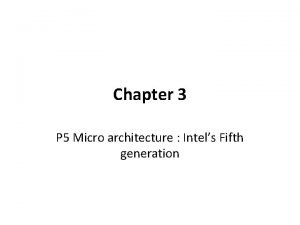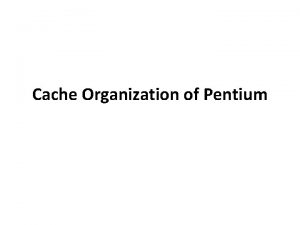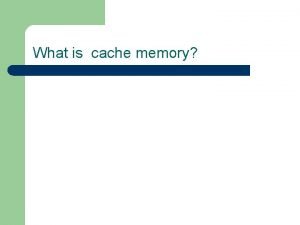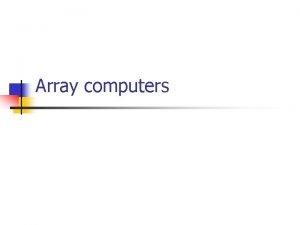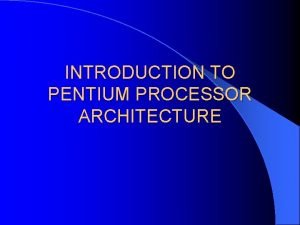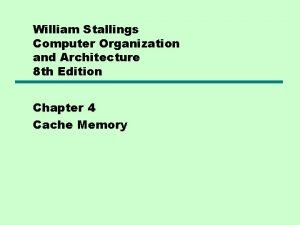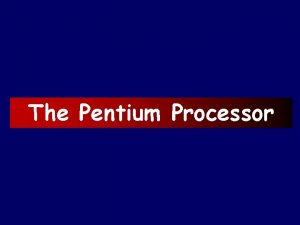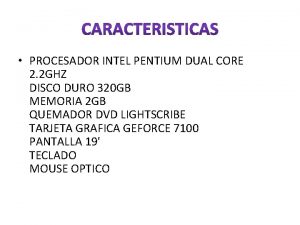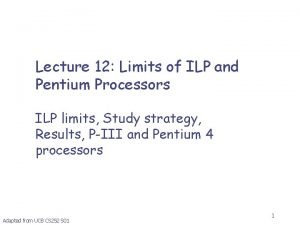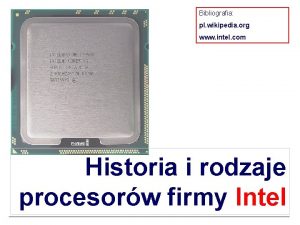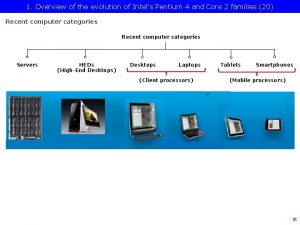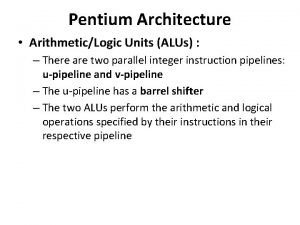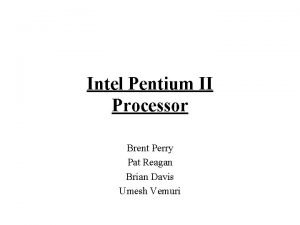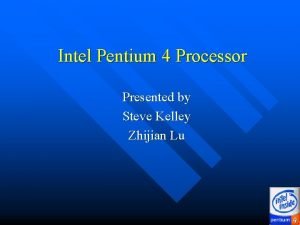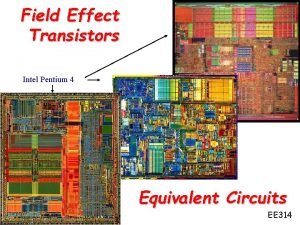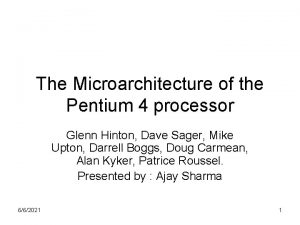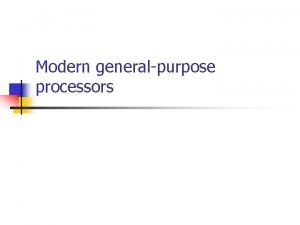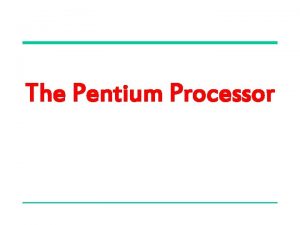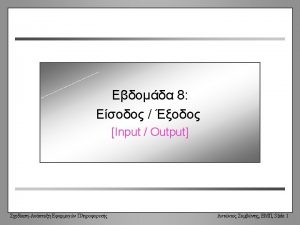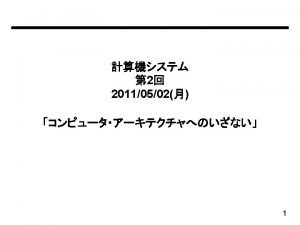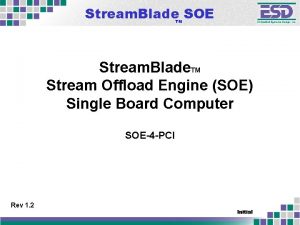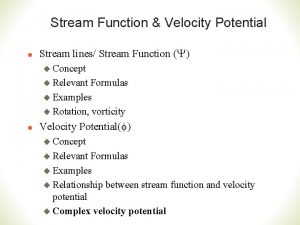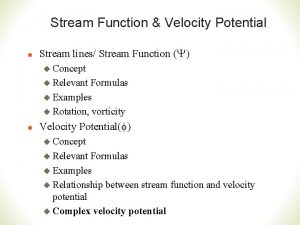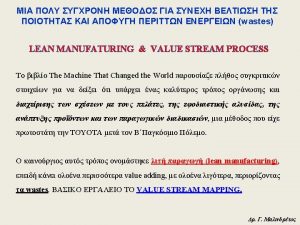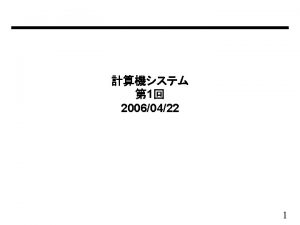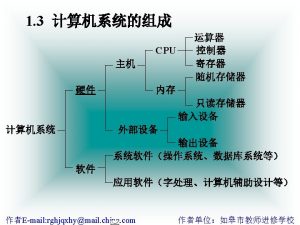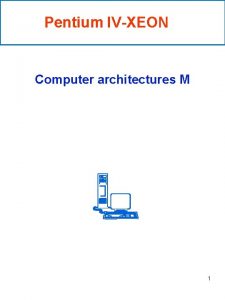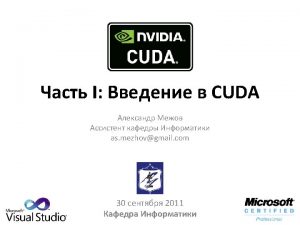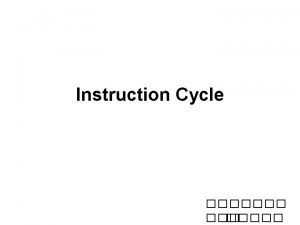Pentium III Instruction Stream Introduction Pentium III uses


























- Slides: 26

Pentium III Instruction Stream

Introduction Pentium III uses several key features to exploit ILP This part of our presentation will cover the methods that the third generation P 6/IA 32 architecture uses and their advantages/disadvantages.

Features • Completely speculative execution • superscalar issue • Speculative register renaming • Deeply pipelined execution • Large branch prediction unit

Pentium III Execution • Deeply Pipelined – Over 30 stages for many ops (without miss penalties) – Several tradeoffs for deeply pipelined models • Stall penalties • Clock rate

Pentium III Execution Model • Consists of – In-order front end/issue – Out of order execution core – In order retirement unit (non-speculative)

Front End Execution • ICache access • Branch prediction • Decode • Issue

ICache • Icache is – 16 KB , 4 way set associative, 32 byte cache lines • L 2 (unified)

Branch Prediction • BTB (branch target buffer) decides address of next executed instruction • Speculative state advantages – Less complicated recovery – Less Mispredict costs • BTB runs off of prefetch

Branch Prediction (Cont. ) • Dynamic predictor – Yeh’s algorithm – last 4 directions available per branch address – One cycle disadvantage on taken branches – RSB

Branch Prediction (Cont. ) • Static predictor – 6 cycle penalty – Forward branches(not taken) – Backward branches(taken)

Decode • Three decode units – Two simple, one complex • Micro ops – RISC type operations • Can be 1 -4 per CISC operation

Decode (Cont. ) • Issue problems arise – Program instruction ordering very important • Tradeoff – Issue of 4 -wide instructions improves compiler performance by allowing more optimization

Decode (Cont. ) • Williamette (last IA 32 architecture) has – Execution trace cache • Immediately accessible (no cache hit delay) • Exploits temporal locality

Execution • Micro-ops follow distinct trails – RAT (register alias table) – ROB (re-order buffer) – Reservation station – Execution units

RAT • Register Mappings (source, destination) – Eliminates false dependencies • In-Order Retirement – Allows out of order execution from ROB • Issues up to 3 micro-ops to ROB per cycle – See any throughput problems?

RAT (cont. ) • Can access either ROB or RRF – Solves true dependencies – State bits required • Branch Mispredicts? – Flush all state(mappings) older than branch – No new mappings until all current instructions retired

ROB • ROB is temporary location of queued micro-ops • 40 entries – Contain micro-ops, state, and results

ROB states • SD – Scheduled for execution • DP – Micro-op is at head of dispatch queue • EX – Currently being executed • WB – Completed execution; waiting for results • RR, RT – Ready for retirement, being retired

Reservation Station

Reservation Station (Cont. ) • 5 ports for different ops – FP, Int, MMX, SSE, LSQ ops – More throughput problems? • 20 entry queue – Organization not specified

Execution • Scheduling – One scheduler for each port – 20 entry queue optimized by priority algorithm • Dispatch – All 5 ports can be dispatched every clock cycle

Execution (Cont. ) • Dispatch – Dcache misses, hazards resolved – Results written back to ROB • Resolves dependency chain

Retirement • Results written to RRF – Non-speculative state – Register maps deleted, if possible

Throughput

Area Considerations • As it turns out – IA 32 architecture doesn’t scale entirely well • Die area a large problem • Bus / logical complexity grows in non linear fashion

Finally • It seems that – IA 32 is at an end – VLIW is next
 Branch prediction logic in pentium processor
Branch prediction logic in pentium processor In pentium data cache is of
In pentium data cache is of Pentium iii
Pentium iii Differentiate byte stream and character stream
Differentiate byte stream and character stream Sisd processor
Sisd processor Single instruction stream
Single instruction stream Intel pentium processor architecture
Intel pentium processor architecture Differentiated instruction vs individualized instruction
Differentiated instruction vs individualized instruction Direct vs indirect instruction
Direct vs indirect instruction Hamlet act iii scene iii
Hamlet act iii scene iii Pentium 4 cache organization
Pentium 4 cache organization Pentium processor family
Pentium processor family Compaq presario pentium 2
Compaq presario pentium 2 Pentium 4 block diagram
Pentium 4 block diagram Compare architectural features of 80386 with 8086 processor
Compare architectural features of 80386 with 8086 processor Intel 8086 wikipedia
Intel 8086 wikipedia Pentium evolution
Pentium evolution Pentium architecture
Pentium architecture Pentium 1
Pentium 1 Intel pentium processor
Intel pentium processor Pentium 4 processor
Pentium 4 processor Two steps
Two steps Ocs architecture
Ocs architecture Arbitate
Arbitate Superscalar architecture diagram
Superscalar architecture diagram Intel pentium
Intel pentium Paralleilism
Paralleilism
